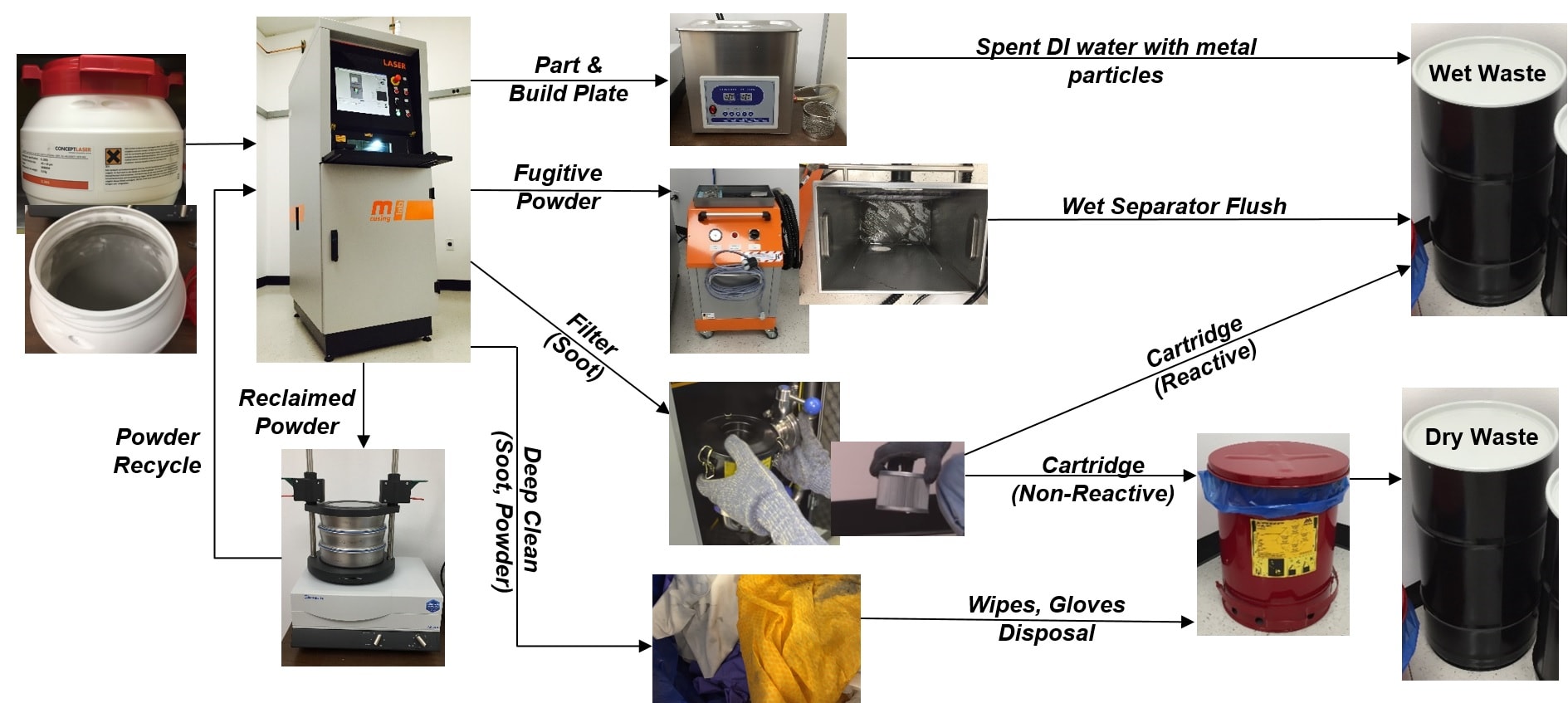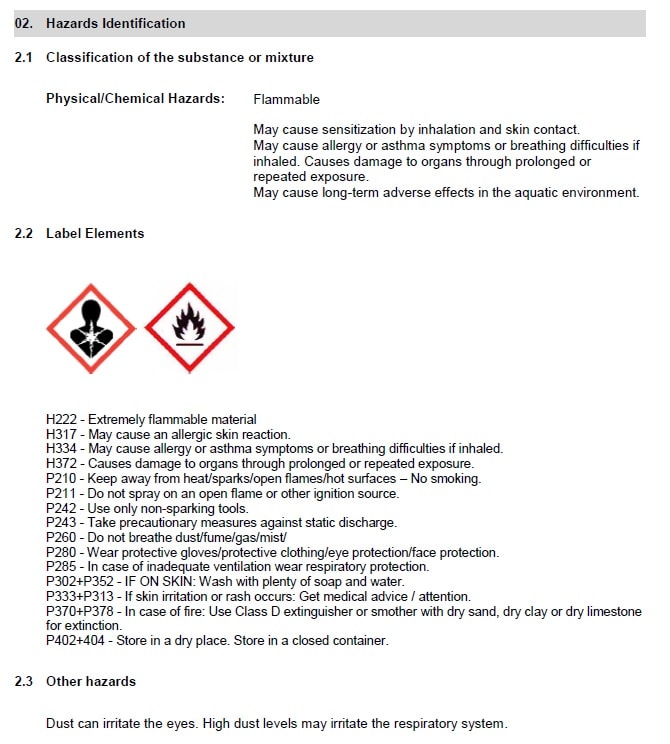After installing our first Laser Powder Bed Fusion Additive Manufacturing system, we learned a lot, and while he was at PADT, Dhruv Bhate kindly wrote up a series of blog posts on what we learned.
Here are the articles:
If you prefer, you can register for a webinar to be held on July 26 @ 2pm EDT (US) where I will be summarizing all 5 parts of this blog series. Register by clicking on the image below:
1. Sources of Waste
As shown in Figure 1 below, metal powder used in this process ends up in dry and wet waste. The dry waste can be composed of wipes and gloves with powder and soot, and the wet waste is mostly composed of water and suspended metal particles (from the wet separator and ultrasonic cleaner), and for reactive alloys, can also consist of filter cartridges that need to be suspended in water throughout. Because the wastes contain metal powders, we must stop and ask if this is safe for sending to our landfills and into our sewers where there is a risk of contaminating groundwater and creating other long term environmental havoc.
Thus, the first question is: are these wastes hazardous?

2. Is this Waste Hazardous?
There are two sources for this information: the EPA (in the US) and the powder supplier’s data sheets. It helps to begin by understanding some definitions – statements in italics are quoted from the EPA, the rest of the text is mine.
- Waste: “A waste is any solid, liquid, or contained gaseous material that is discarded by being disposed of, burned or incinerated, or recycled“
- Hazardous Waste: There are several types of hazardous waste and associated definitions of each. The two main categories are:
- Listed Waste: “Your waste is considered hazardous if it appears on one of four lists published in the Code of Federal Regulations (40 CFR Part 261).” I have looked at this list and to the best of my knowledge, no metal powders of concern to the metal 3D printing process appear on this list (as of July 10, 2017). The metal powders currently used are also not considered acute hazards.
- Characteristic Waste: In addition to listed wastes, the EPA specifies certain characteristics that a waste may possess (even if not listed) that would make it hazardous. In the context of metal powders, the potentially relevant categories are:
- “It catches fire under certain conditions. This is known as an ignitable waste”.
- “It is harmful or fatal when ingested or absorbed, or it leaches toxic chemicals into the soil or ground water when disposed of on land. This is known as a toxic waste.”
Due to the generality of the definitions of “Characteristic Waste,” and the lack of available data in the public domain such as from a TCLP test (Toxicity Characteristic Leaching Procedure), it is hard to dismiss these as not being relevant. For each of our waste streams, consider the arguments below:
- Dry Waste: We know that given the right conditions and an ignition source, that these powders, especially reactive alloys and combustion products, can ignite.
- Wet Waste: We also know that while water serves as a passivation for powders, we cannot guarantee that the powder will always stay in wet state if it is not disposed as such. Evaporation, for example, can leave behind combustible powder.
Another source of hazard information is the Safety Data Sheet (SDS) or Material Safety Data Sheet (MSDS). Some metal powders are more hazardous than others, so when planning, consider looking at all the alloys you may possibly be using in the future and ask for SDS sheets on all of them. One example, is of Ti6Al4V powder below, clearly showing significant hazards present.

3. What Regulations do I need to be aware of?
The EPA established three categories of waste generators in their regulations, listed below along with the relevant quantity of waste generated and stored, for our purposes (visit EPA’s site for the full list, this is not comprehensive) – EPA cites these numbers in hundreds and thousands of kilograms, hence the strange numbers below (in lbs):

Note this is the sum total of all hazardous wastes your site is generating (in our case, dry and wet wastes combined), not a limit per category. Depending on what category you fall in, you will need to follow EPA’s regulations, available here. Additionally, some states may have additional regulations and this is where I only have studied this problem for my home state of Arizona, which is in line with the EPA’s federal guidelines and does not, to the best of my knowledge, impose additional restrictions. The full list by state is here. If you are a “Very Small Quantity Generator” as we are at PADT, the regulations are fairly straightforward and involve three items (quoted from the EPA’s site) – the requirements are more stringent for larger quantities.
- VSQGs must identify all the hazardous waste generated.
- VSQGs may not accumulate more than 1,000 kilograms of hazardous waste at any time.
- VSQGs must ensure that hazardous waste is delivered to a person or facility who is authorized to manage it.
At PADT, we contract with an industrial waste disposal company that picks up and replaces our waste containers. Yes, this adds cost to the process and at least one company has developed a method to significantly reduce (Editor’s Note (6/27/2022): Sadly, this company appears to no longer be in business) wet waste (which tends to be the larger of the two) by employing a filtration device. Similar innovations and a general focus on reducing waste can drive these costs down.
4. Opinion
As with all regulations, one can approach them by focusing on the specificity of the language. While this is important, it is also useful to seek to understand the intent of the regulation. When it comes to these wastes, I ask if I would be comfortable carrying it in my car and disposing of it in my hypothetical backyard landfill (dry waste) or my local water body (wet waste) – and the answer to both, for me, is a NO. So why should I ask my city to do this? This is understandably an exaggerated way of looking at the problem, but I believe at a minimum, serves as a risk-conservative upper-bound that is useful when addressing uncertainty in these matters.
You can read the final installment of this series, on housekeeping, here.
5. References
- EPA, Hazardous Waste Generators Home Page
- EPA, Categories of Waste Generators
- EPA e-CFR, Title 40, Part 261
- US Environmental Agencies by state
Disclaimers
- This is intended to supplement the supplier training you must receive before using the equipment and not meant to replace it – in case of conflicting information, your supplier’s training and equipment requirements override any discussion here.
- Local, state and federal regulations vary and are important – partner with your local environmental authorities when making decisions
- My personal experience derives specifically from the use of Laser-based metal 3D printing tools, specifically Concept Laser’s MLab Cusing R equipment. I expect majority of this information to be of use to users of other laser based powder bed fusion metal systems and to a lesser extent to Electron Beam systems, but have no personal experience to vouch for this.
- PADT and the author assume no legal responsibilities for any decisions or actions taken by the readers of this document or of subsequent information generated from it.
Continue Reading:



















